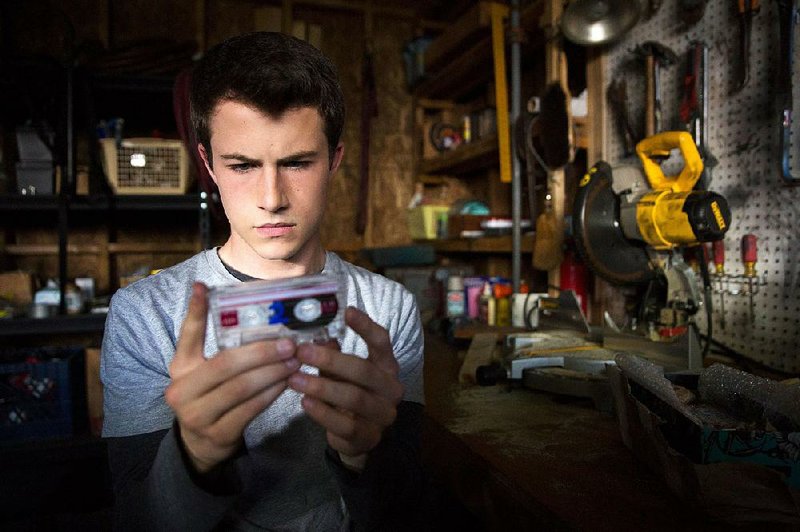RALEIGH, N.C. -- Hannah dies.
She's only 17, and she chooses to end her life.
Hannah's story is fictional, portrayed in the popular Netflix series 13 Reasons Why, which is based on a novel by Jay Asher. But her story is familiar. Suicide was the second leading cause of death for people ages 10 to 24 in 2014, second only to unintentional injuries, according to the Centers for Disease Control and Prevention.
Since its release March 31, 13 Reasons Why, starring Katherine Langford as Hannah and Dylan Minnette as Clay Jensen, a classmate who attempts to uncover the story behind Hannah's death through a series of cassette tapes she leaves behind, has been the most tweeted-about TV show of the year. Discussions around the series continue a month and a half after its release.
And earlier this month, it was announced the series had been renewed for a second season, which will premiere in 2018.
13 Reasons Why raises tough questions about bullying and sexual assault. It has drawn criticism from some, who say it can do more harm than good, especially to vulnerable teenagers.
We asked some questions about the series and its impact, and here's what we learned.
Should teenagers watch the series?
The series is rated MA, for mature audiences. That means it isn't meant for children under 17 because it features bad language, sex or graphic violence.
For that reason, teenagers should avoid tuning in, says Barbara-Ann Bybel, director of psychiatry services at University of North Carolina Hospitals in Chapel Hill, N.C.
But teenagers, and parents, don't always pay attention to ratings.
"Kids are watching it, whether or not they should," says Nicole Heilbron, co-chief of the Division of Child and Family Mental Health & Developmental Neuroscience at Duke University in Durham, N.C. "It's really up to parents whether they feel it's appropriate for their kids."
The Wake County school system in North Carolina recently posted a statement on its website recommending that students not watch the show.
"However, if your student is going to or already has watched the series, we encourage you to watch it together and discuss your reactions to the issues raised in the series," says Bren Elliott, Wake's assistant superintendent for student support services, in the statement.
According to a handout from the National Association of School Psychologists, it is not recommended "that vulnerable youth, especially those who have any degree of suicidal ideation, watch this series."
What kind of discussions should we have about it?
It's good for teenagers to talk about suicide, Heilbron says, and parents and school leaders shouldn't avoid the topic.
"This is an opportunity for really opening a conversation," she says.
Parents can use the show to talk to their kids about the dangers of bullying and also what it means to be a good friend, says Kristen Stefureac, a social worker at Duke.
Bruce Ham, who blogs about his experiences as a single father of three teenage daughters, says the series sparked discussions in his family about what would lead someone to die by suicide and how Hannah's situation could have been handled differently.
"You get into their minds a little bit and you see what they're thinking and how they're processing it," says Ham, 51, who lives in Raleigh. "It's all about having open dialogue with your kids and listening -- spending more time listening to them than talking."
Does the series glamorize suicide?
In some ways, yes.
The show revolves around a series of recorded tapes in which Hannah explains painful experiences she had with her peers. Viewers might think Hannah played a bigger role in their lives -- that she was finally noticed for who she was -- after her death.
Bybel says she is worried some teenagers who consider suicide will get the wrong idea.
"I don't want them to get the false impression a TV show will be made in their honor," she says.
It's widely considered a bad idea to show graphic images of suicide. Some studies have shown such images can lead to people dying by suicide using the means depicted.
Does it ignore mental illness?
Some people say Hannah's death was "revenge suicide," a way to get back at the people who bullied, betrayed and violated her. The show does not focus much on mental illness or how Hannah might have been depressed.
Heilbron says recurring thoughts of death and suicide are a symptom of depression, a common mental illness marked by sadness and loss of interest. About 12.5 percent of adolescents ages 12 to 17 in the United States had at least one major depressive episode in 2015, according to the National Institute of Mental Health.
Experts agree that being bullied or traumatized in other ways can lead to depression and anxiety. But most kids who experience bullying or trauma such as sexual assault don't die by suicide, Heilbron says. Researchers are working to understand the relationship between trauma and suicide.
Depression is a disease that can be treated with medication, therapy or a combination of both. The series falls short in getting that message across, Heilbron says.
"I would really want to see it portrayed across the show that suicide is a preventable death," she says.
Other characters on the series display obvious symptoms of depression, although it's not directly addressed.
Jessica starts drinking alcohol heavily (and by herself), and she begins acting impulsively. Her boyfriend, Justin, isolates himself and misses school, even though he's the star of the basketball team and there's a big pep rally. It's clear that Skye self-harms by making cuts on her wrists.
Kenna Haney, a 15-year-old sophomore at Sanderson High School in Raleigh, agrees the series doesn't focus much on Hannah's state of mind. Hannah continues to go to school, she wears makeup and fixes her hair, and she smiles.
All of that can be deceiving, Haney says.
"I guess that's the point -- that you don't always see that people are depressed," she says.
Can we blame the people left behind?
It's not fair to place blame on others when someone dies by suicide, Bybel says.
"They did not control the decisions and actions the other person made," she says.
People who choose to end their lives are typically so depressed that they don't focus much on others, Bybel says.
"Usually when someone is thinking about suicide, they're not thinking about the people they're leaving behind," she says. "They're thinking about them being in so much pain, there being an end to the pain."
What did the series get wrong?
There's not much focus on social media. When a boy takes an embarrassing photo of Hannah, he texts the image to his friends. A "hot or not" list that makes its rounds through the school is written with pen and paper.
In real life, many of teenagers' interactions -- negative and positive -- take place online, including on Instagram and Snapchat.
"A lot of bullying happens on social media that people don't realize," Haney says.
It's important for parents to know what their kids are doing online and how they're interacting with others, Heilbron says.
Is it dangerous to ask teens if they are considering suicide?
No.
A common misconception is that adults should not ask children if they are thinking about suicide because it might spark the idea, Heilbron says.
"The danger really is in not asking and making it a topic that can't be discussed and is stigmatized," she says.
Teenagers need someone to listen without being judgmental or dismissive, Heilbron says.
Who should teens go to if they're struggling?
In the series, Hannah talks to a guidance counselor who is less than helpful. But teens shouldn't shy away from seeking help.
"If they don't get the support they need ... then go to another adult," Heilbron says.
Anissa Holm Baumgartner, a mother and a media specialist at a North Carolina high school, says students should talk to a teacher, athletic director, club adviser or counselor -- anyone who can help.
"We really want every student to have one adult in the building they feel comfortable with," she says. "It's hard at these big public high schools."
Haney, the Sanderson student, says she would go to her parents and her friends if she needed help.
Is help available?
The National Suicide Prevention Lifeline is a free and confidential service available 24 hours a day. The number is (800) 273-8255.
For the service in Spanish, call (888) 628-9454
Family on 05/17/2017




